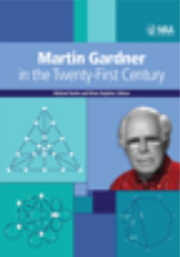Book contents
- Frontmatter
- Preface
- Contents
- I Geometry
- II Number Theory and Graph Theory
- III Flexagons and Catalan Numbers
- IV Making Things Fit
- V Further Puzzles and Games
- VI Cards and Probability
- 30 Modeling Mathematics with Playing Cards
- 31 The Probability an Amazing Card Trick Is Dull
- 32 The Monty Hall Problem, Reconsidered
- 33 The Secretary Problem from the Applicant's Point of View
- 34 Lake Wobegon Dice
- 35 Martin Gardner's Mistake
- VII Other Aspects of Martin Gardner
- Index
- About the Editors
35 - Martin Gardner's Mistake
from VI - Cards and Probability
- Frontmatter
- Preface
- Contents
- I Geometry
- II Number Theory and Graph Theory
- III Flexagons and Catalan Numbers
- IV Making Things Fit
- V Further Puzzles and Games
- VI Cards and Probability
- 30 Modeling Mathematics with Playing Cards
- 31 The Probability an Amazing Card Trick Is Dull
- 32 The Monty Hall Problem, Reconsidered
- 33 The Secretary Problem from the Applicant's Point of View
- 34 Lake Wobegon Dice
- 35 Martin Gardner's Mistake
- VII Other Aspects of Martin Gardner
- Index
- About the Editors
Summary
Martin Gardner was amazingly accurate and reliable. That he made a mistake is simply testimonial to the difficulty of this particular problem, which appeared in 1959 and was republished in [3]:
Mr. Smith has two children. At least one of them is a boy. What is the probability that both children are boys?
Mr. Jones has two children. The older child is a girl. What is the probability that both children are girls?
Mr. Jones has failed to stir any controversy, so we ignore him and his two children [5]. Instead, we concentrate on Mr. Smith. Here is the solution that Martin Gardner published with the problem:
If Smith has two children, at least one of which is a boy, we have three equally probable cases: boy-boy, boy-girl, girl-boy. In only one case are both children boys, so the probability that both are boys is ⅓.
The corrected solution
Later Martin Gardner wrote a column titled “Probability and Ambiguity,” which was also republished (in [4]). In this column Gardner corrects himself, writing “… the answer depends on the procedure by which the information “at least one is a boy” is obtained.”
He suggested two potential procedures.
(i) Pick all the families with two children, one of which is a boy. If Mr. Smith is chosen randomly from this list, then the answer is ⅓.
[…]
- Type
- Chapter
- Information
- Martin Gardner in the Twenty-First Century , pp. 257 - 262Publisher: Mathematical Association of AmericaPrint publication year: 2012



